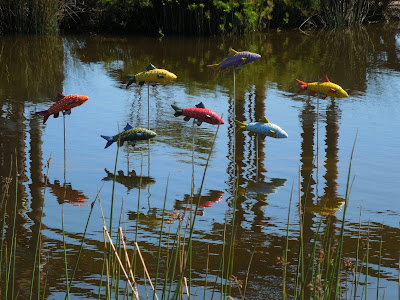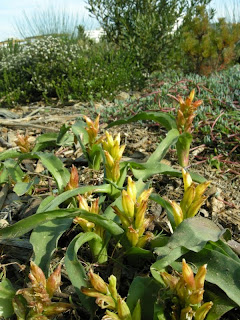During a recent visit to Random Harvest Nursery I had the privilege of visiting a restored grassland. About 25 years ago this piece of the farm was a dense stand of alien invasive Black and Silver Wattles. Linda de Luca and her mother decided to remove the forest and allow the grass to re establish itself, initially for grazing purposes. Then about 12 years ago, their interest in grassland deepened and they decided to play a more active role in restoring the grassland. The result is spectacular: a little piece of climax high veld grassland in the heart of Gauteng, and only a stone's throw from the bustling centre of Johannesburg.
It was an overcast day after a few days of rain - the grasses were lush green and flowering, in their prime. Eragrostis curvula, Eragrostis capensis (heart love grass) and Themeda triandra (red grass) were a few that I could name. in this matrix of finely textured green were splashes of yellow Helichysum, and the striking tall inflorescenes of prickly Berkheya.
I was lucky to have Carol Knoll as my guide - she had just published an excellent article on the restoration of this grassland in Footprint Limited magazine. As we walked through the grassland, we were like kids in a candy shop, excitedly pointing out little herbaceous gems under our feet.
Carol showed me how the Milkwort was alive with insect activity - ants, beetles and of course butterfly pollinators.
The star flowers remained firmly closed, in the absence of sun, but below is a picture I took in the same grassland last year.
As we left the restored grassland, I saw a dense stand of Hyparrhenia hirta and wondered how this local but weedy invasive species was kept in check? I found the answer in Carol's article which describes how the Hyparrhenia was cut and removed before it seeded, and used to make compost for the nursery. In addition, the grassland is regularly weeded to remove pompom weed, tall verbena and Plantago. To increase biodiversity and provide different conditions, the grassland is burnt every 3 years, and slashed annually, with one third slashed in autumn (March), one third in spring and the remainder left untouched. Quite a regime, but it has yielded excellent results.
In addition to the spectacular increase in plant diversity, the restored grassland has provided a habitat for the Giant bullfrog and many species of butterfly, including the Eyed Pansy.
As I left - in great haste - to catch my plane at Lanseria airport I spotted a Waving pelargonium - a fitting end to my grassland visit.























.jpg)
.jpg)
.jpg)











